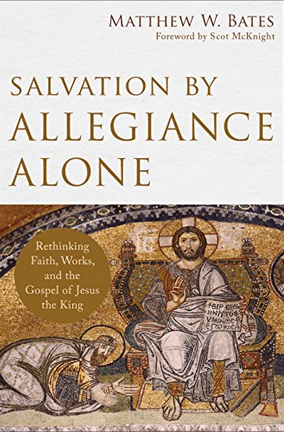 Salvation by Allegiance Alone: Rethinking Faith, Works, and the Gospel of Jesus the King
Salvation by Allegiance Alone: Rethinking Faith, Works, and the Gospel of Jesus the King
by Matthew Bates
This is an inspiring sequel to Scot McKnight’s The King Jesus Gospel and takes understanding the gospel message to an even greater level. This is not some abstruse theological book. It is eminently practical and very inspiring. It glorifies our risen Lord and King. The thesis of the book is that faith is better translated “allegiance,” under which more traditional understanding of faith, such as mental agreement and trust, are subsumed.
He quotes Josephus, a contemporary author from the general time period of the writing of the gospels.
Josephus was not trying to convince this rebel to turn away from private sins or to “believe” that God can forgive, rather Josephus wanted this man to join him in supporting the Jewish cause— that is, as I would put it, to show allegiance. So, what “repent and believe in me” means for Josephus in this context is “turn away from your present course of action and become loyal to me.” [Bates, Matthew W.. Salvation by Allegiance Alone: Rethinking Faith, Works, and the Gospel of Jesus the King (pp. 4-5). Baker Publishing Group. Kindle Edition.]
Bates argues convincingly that the apex of the gospel message is not the crucified Christ but the risen and ascended Christ, who became Lord of Lords. The Lamb of God ministry, which culminated in Jesus’ crucifixion, was necessary to God’s being able to offer reconciliation to his rebellious creation, but the ascended Lord is he with whom we must relate now.
Faith Is Not
In this chapter Bates begins to lay the groundwork for his arguments that follow. He shows that true faith, while dependent of the revelation of the Spirit, is not anti-reason.
The key point is that true pistis [Greek: faith] is not an irrational launching into the void but a reasonable, action-oriented response grounded in the conviction that God’s invisible underlying realities are more certain than any apparent realities. (p. 20)
Faith will always produce a response toward its object. Faith in our Lord will result in acts of obedience grounded in that faith.
Furthermore, if we were to determine that in appropriate salvation-oriented contexts in the New Testament pistis most likely means faithfulness, or fidelity, or allegiance, then might not pistis by its very definition include concrete acts that are inseparable from allegiance? (p. 22)
This is the context in which James’ teaching must be understood. Faith without works is dead.
Loyalty and the Full Gospel
In this chapter Bates argues that over the years many have presented a skewed and truncated gospel, which is consumer oriented and presents Jesus as the answer to our need or desire to be forgiven and go to heaven without requiring anything of us. In this “gospel” discipleship is optional.
In reading Paul’s summary of the gospel, we quickly recognize that the gospel is not at its most basic level a tale about me and my quest for salvation (or even about “us” and “our” quest), but rather it is a grand, cosmic story about God’s Son and what he has done. (pp. 31-32)
In the truncated gospel, all that is required is a decision to accept what Christ provided coupled with a profession of faith (mental assent) to that truth. This misses the bigger picture that Jesus is now risen as Lord of lords and asks for total surrender.
That Jesus died for our sins and, as a portion of that “our,” that he also died for my sins is truly part of the gospel— emphatically so!— but it is imperative to realize that it is only a small but vital portion of the gospel as properly understood, not the whole gospel. It is also critical to recognize that “faith” is not primarily aimed at trusting in the forgiveness-of-sins process. For Paul does not primarily call us to “faith” (“ belief” or “trust”) in some sort of atonement system in order to be saved (although mental affirmation that Jesus died for our sins is necessary), but rather to “faith” (“ allegiance”) unto Jesus as Lord. (p. 39)
Thus allegiance to our Lord becomes the demonstration of repentance from going our own way. Water baptism is a public confession of allegiance to Christ. The early martyrs were not put to death for confessing that Jesus was their personal Savior, but for refusing to deny allegiance to Christ the Lord.
We have noted that the gospel proper is not so much a story focused on “believing that Jesus died for my sins” or “trusting in Jesus’s righteousness alone” as it is a power-releasing story about Jesus, the one who is now ruling as the allegiance-demanding Lord of heaven and earth. (p. 44)
Jesus Proclaims the Gospel
In this chapter Bates builds on what Scot McKnight brilliantly proves in The King Jesus Gospel.
My point is simple: there is only one gospel, and just as in Paul’s Letters, it is the transformative story of how Jesus, who preexisted as Son of God, came to be enthroned as the universal king. (p. 47)
He shows that Jesus proclaimed the gospel, just as did Paul. The gospel is not a presentation of justification by faith, although that doctrine is clearly derived from it, but it is the announcement that the promised king has arrived and now is seated on his heavenly throne waiting for his Father’s perfect timing to return as the glorious Son of Man who will judge the living and the dead.
Jesus proclaimed the one gospel by announcing the inauguration of the kingdom of God as well as its anticipated culmination. (p. 47)
Bates points out that the gospel…
…is the story of how Jesus the Son, who was chosen far in advance by God as the appointed Messiah, was anointed by God at his baptism as the designated Messiah, and then came to be the enthroned Messiah after his resurrection from the dead— the story of how the kingdom of God was made a concrete this-world reality when Jesus was installed as king and given authority to rule, uniting heaven and earth. (p. 50)
Properly understanding the gospel is important and often missed. Instead of being a presentation of God’s solution to the human need for forgiveness and reconciliation to God, it is…
“the story about Jesus’ career, a career that culminates in his attainment f heavenly authority.” (p.51)
When the gospel is properly presented, we gain a better understanding of the nature of faith (pistis).
Properly speaking, pistis is not part of the gospel but the fitting response to the gospel. Moreover, our justification is not part of the content of the gospel proper either; only Jesus’s justification is, inasmuch as the resurrection is the effect of his being declared righteous. Our justification is a result of the gospel when we are united by pistis to Jesus the atonement-making king. (p. 54)
Bates argues that the most important element of the gospel for us today is present heavenly reign.
We need to recover Jesus’s kingship as a central, nonnegotiable constituent of the gospel. Jesus’s reign as Lord of heaven and earth fundamentally determines the meaning of “faith” (pistis) as “allegiance” in relation to salvation. Jesus as king is the primary object toward which our saving “faith”— that is, our saving allegiance— is directed. (p. 67)
Bates argues that first and foremost the gospels present Jesus as the enthroned king of heaven to whom all allegiance is due.
Faith as Allegiance
This chapter is the heart of the book. In it he dives deeper into examining his claim that our English word “faith” can best be defined as allegiance.
…allegiance is a better overarching English-language term for what Paul intends with his use of the pistis word group than the more customary faith, belief, and trust. Now for four specific arguments in favor of allegiance. First, although pistis does not always mean allegiance, it certainly does carry this exact meaning sometimes in literature relevant to Paul’s Letters and the rest of the New Testament. Second, since Paul regards Jesus above all else as the king (the Christ) or the Lord, this is the most natural way for Paul to speak of how the people of God should relate to Jesus. Third, allegiance makes better sense of several otherwise puzzling matters in Paul’s Letters. Fourth, the proclamation “Jesus is Lord” resonated with Greco-Roman imperial propaganda, so that pistis as allegiance fits into the broader cultural milieu of the New Testament world. Bates, (p. 78)
I will not go into the depths of his arguments here, but they are very convincing. He claims that more traditional definitions of faith are subsumed under the idea of allegiance.
Paul’s use of pistis here shows that this word in and of itself does not map perfectly onto the English word allegiance; rather it can and does often refer to mental assent to a certain proposition and confidence in the reliability of God’s promise. Here for Paul pistis does mean something like “trust.” But I submit that our English term allegiance is a larger category capable of subsuming the notion of mental assent to the reliability of God’s testimony (belief) or of God’s promises (trust), while also foregrounding the idea that genuine mental assent goes hand in hand with an allegiant or faithful (pistis-full) living out of that assent. In other words, yes, Paul and others do say that we must believe or trust, but these metaphors are best adjusted and subsumed within the richer category of allegiance. Consistent trust in situations of duress over a lengthy period of time is allegiance. (p. 90)
He concludes that faith (pistis) has three dimensions.
…mental affirmation that the gospel is true, professed fealty to Jesus alone as the cosmic Lord, and enacted loyalty through obedience to Jesus as the king. This is a deliberate alternative to classic definitions of “faith.” (p. 92)
He argues that mere mental agreement with the facts of the gospel coupled with a profession of loyalty to Christ must be accompanied by a life of obedience to prove the reality of salvation. As Paul wrote, the goal of his gospel was to produce the obedience of faith. (Romans 1:5)
Questions about Allegiance Alone
In this chapter Bates addresses a number of questions related to his thesis. He stresses that though our salvation requires enacted loyalty to Christ, it is always by grace. He insists that grace always comes with strings attached, however.
The matter, I submit, is essentially no different if we understand pistis as allegiance to Jesus, the cosmic king. We are still saved by grace through pistis; salvation comes from outside ourselves as the Christ gift. Yet we must respond to that gift by giving allegiance to Jesus as Lord. The offer of salvation is free, but it absolutely does come with strings attached. Obedient loyalty to the king is required as a condition of acceptance. pp. 103-104)
He states that ancient understandings of grace always included reciprocation.
In short, we cannot say in an unqualified fashion that final salvation is by grace and by faith apart from embodied obedience, for this misunderstands the nature of both charis (“ grace”) and pistis (“ faith”) in antiquity and in Paul’s Letters. (p. 105)

The reciprocation of unmerited grace that God is looking for is our unqualified worship and surrender to Christ the king. My friend, Mike Osminski, pastor of Lord of the Harvest Church in the Detroit, Michigan area, offered this additional insight.
In "Paul and the Gift," John M. G. Barclay emphasizes the radically new and previously undiscovered nature of grace as revealed in the New Covenant is the reason that is so powerful of a concept in terms of the Gospel. Paul's presentation of the utter giftedness of grace surpasses anything the ancients thought about gift giving and graciousness. It is one of the main reasons that pure grace can only come from God and it has no perfect analogy in anything the ancients came up with. Barclay saw Six Perfections of Grace in the NT (by perfections he means aspects of grace that help to define both its nature and its purpose; it is defined by what it accomplishes). Grace is characterized by its Superabundance (its excess, its significance, its permanence). This is seen in Romans 5:12-21 wherein Paul says that "where sin abounded, grace superabounded." Singularity (this focuses on the God of grace whose sole and exclusive mode of operation is His benevolence and goodness). This is seen in many verses that speak of God's kindness and goodness (moral excellence) in all that he is and does. His grace is characterized by His singular graciousness (unlike what any other can provide). Priority (God's gift of grace takes place always prior to the initiative of the recipient. As the initiating move, the prior gift is not a reaction to a demand or request and thus is spontaneous in its generosity; it is not obliged by a previous gift and is thus absolutely "free"; it signals the superiority of the giver who is not in a subordinate position of returning a gift). This is seen in Ephesians 2:1-10 & II Timothy 1:9. Incongruity (a perfect gift is given without condition [contra Bates], that is, without regard to the worth of the recipient; an incongruous gift is supremely excellent precisely because it does NOT take account of prior conditions of worth). This is seen in Titus 3:3-7 and Romans 4:4. Efficacy (grace fully achieves what it is designed to do). This is seen in a great number of verses,including I Corinthians 15:10 (in terms of ministry), II Corinthians 4:15 (in terms of God's glory),II Corinthians 12:9 ( in terms of Christian life), Ephesians 1:6,7 (in terms of redemption & incorporation In Christ), II Thessalonians 2:16 (in terms of eternal life), and Titus 2:11 (in terms of sanctification). Non-Circularity (is seen by the fact that God's gift of grace escapes reciprocity, the system of exchange or quid pro quo that characterizes a sale, a reward, or a loan; this demonstrates the notion of a truly "pure" gift, no strings attached [contra Bates]; this form of perfection could only be bequeathed by God, who alone needs no return and therefore could give without such expectation). Here he quotes Philo (Jewish theologian at the time of Christ who wrote in Greek):"But God, is no salesman but a giver of everything, pouring out eternal fountains of gifts and seeking no return. For he needs nothing and no created being is capable of giving him back a gift." He does this as an example of Second Temple Judaism which contributed to the thought world in which the NT emerged (similar to Bates's quote of Josephus). Barclay goes into a lengthy discussion of how this aspect of Paul is seen in Romans 9-11 and the fact that the same Israel that rejected Messiah will yet be saved based on God's non-circular grace (Romans 11:5-6)I do not think this disproves Bates's "allegiance" motif but rather shows the incredible greatness of the NT's concept of grace and must be taken together with the allegiance concept as a manifestation of the Gospel.
Bates argues that works of faith are the embodiment of allegiance to Jesus the King.
…it is the allegiance to the king himself that counts rather than performance of the Mosaic law, …since allegiance (pistis) to Jesus as king demands obedience to the deepest intentions of the law of Moses (see Matt. 5: 17– 48) even though this law has now reached its climactic goal (Rom. 10: 4). At the final judgment, we will not be evaluated on the basis of whether we kept a list of rules such as the Ten Commandments, except inasmuch as genuine fidelity to Jesus the king demanded it. (p. 118).
This is his explanation of what it means to live according to the “law of the spirit of life,” of which Paul wrote in Romans 8.
Justification and Allegiance Alone
I do not fully embrace all of Bates’ theology; however, he makes some excellent points worth our consideration. Contrary to Bates, I believe that justification is a once-for-all transaction which seals our eternal destiny, Bates says that our justification is bound up in our remaining “in Christ” through an embodied lifetime of allegiance to him. I do not see where he translates this into a works based approach to salvation. Instead, I think he is merely stating what I think we all believe – that remaining faithful to Christ is an essential part of what it meas to be a disciple. I also agree with Bates that we do not have a righteousness of our own. It is only through being united with Christ by faith and the Spirit that we are righteous. Bates argues that a corporate understanding of justification is warranted, rather than an individual one. Personally I think both are valid.
For Paul, then, the righteousness of God is God’s resurrection-effecting verdict that Jesus the wrath-bearing, sin-atoning, allegiant king is alone righteous— a verdict that all who are united to Jesus the representative king share. This death-unto-resurrection-life verdict is made effective for us as an unmerited gift when we are united by allegiance alone to the death and resurrection of Jesus the king via the Holy Spirit. 26 The result is that “in the Messiah-king” we “become the righteousness of God”; that is, we become the family that has died with the Christ and that has been reconstituted “in him” by God’s declarative (innocence-creating) yet transformative (resurrection-effecting) verdict. Cleared of guilt, final salvation means above all else joining the family that shares the Messiah’s resurrection life. Scripture is clear that this righteousness is properly the king’s righteousness, not our own righteousness, for we receive this resurrection-effecting verdict only “in the Christ”— that is, initially, presently, and finally only through pistis-securing union with Jesus the king, when God declares us righteous “in him.” (pp. 181-182)
According to Bates, we enjoy that righteousness through remaining in an attitude of faith-allegiance to Christ over a lifetime. Nowhere does Bates communicate that this means we “earn” our salvation through obedience. My belief is that faithful obedience over a lifetime is an outcome or “fruit” of the Christ life within every believer. Our fidelity to Christ is also the “proof” of our having this life, which brings glory to God.
Blessed be the God and Father of our Lord Jesus Christ, who according to His great mercy has caused us to be born again to a living hope through the resurrection of Jesus Christ from the dead, 4 to obtain an inheritance which is imperishable and undefiled and will not fade away, reserved in heaven for you, 5 who are protected by the power of God through faith for a salvation ready to be revealed in the last time. 6 In this you greatly rejoice, even though now for a little while, if necessary, you have been distressed by various trials, 7 so that the proof of your faith, being more precious than gold which is perishable, even though tested by fire, may be found to result in praise and glory and honor at the revelation of Jesus Christ; 8 and though you have not seen Him, you love Him, and though you do not see Him now, but believe in Him, you greatly rejoice with joy inexpressible and full of glory, 9 obtaining as the outcome of your faith the salvation of your souls. 1 Peter 1:3-9 (NASB)
I believe that God will keep his people in an attitude of faithfulness through the operation of the gift of faith (pistis). In other words, the same faith that justifies us is the faith will enable us to endure to the end, all through the grace of God. Bates, I think, is viewing things from our side of the equation. We must makes choices to be faithful to God. These choices prove we belong to Christ. Whether or not we view things from the side of God’s faithfulness to us or the side of our responsibility to be faithful to him, I believe that we agree that continuing in faith over a lifetime is essential and proves the reality of our salvation.
Practicing Allegiance
This chapter exhorts the reader to properly present the gospel and is perhaps the most inspiring part of the book for me. Ever since reading McKnight’s The King Jesus Gospel, I have been excited to share the gospel as it really is, rather than as merely a solution to our sin problem. Instead of presenting Jesus as the crucified Lamb of God ONLY, I now understand that it is essential to present him also as the risen Lord, the ascended Baptizer in the Spirit and Lord of the Harvest, and the coming Son of Man who will judge the nations. As such…
We must stop asking others to invite Jesus into their hearts and start asking them to swear allegiance to Jesus the king. (p. 199)
By improperly presenting the gospel, we have allowed “believers” to sidestep discipleship as an optional feature.
…the gospel in our contemporary church culture stems from a failure to see that “Jesus is the king” is the high point of the good news. In a “salvation culture” it may be eagerly acknowledged that “Jesus is Lord,” but Jesus’s cross is what saves us, not his resurrection or lordship, so that lordship can be freely ignored without risking salvation. This is a dangerous error. A “gospel culture,” on the other hand, recognizes that “Jesus is king” is integral to the good news itself, affirming that we indeed are saved by Jesus’s sacrifice and resurrection, but these are only personally effective when allegiance to Jesus as king forges a union with him. (p. 199)
I believe that we must move toward a Jesus is Lord gospel presentation, whether or not we accept Bates’ theology of union based on continued allegiance. I find that declaring that Jesus is the crucified, risen, ascended, and coming-again Lord of lords is a glorious and inspiring way, the altogether proper way, to present the gospel. Such a presentation invites a response of a lifelong surrender to this glorious One.
A presentation of Jesus as merely the crucified Lamb of God who died for our sins so we can go to heaven actually caters to our consumer mindset, instead of inviting us to abandon selfish pursuits in favor of allegiance to the King.
When the full gospel is presented, the call to action is organically embedded in the story. Jesus the enthroned king has summoned everyone, including you and me, to turn away from all other allegiances and to give him exclusive loyalty. (p. 202)
We act as ambassadors for Christ, inviting people to turn away from their self-directed rebellious living and surrender to the ascended King. In so doing, they will be forgiven of past offenses and hostilities. They will be transformed from enemies to children and friends of God, if they will pledge their allegiance to Jesus the Lord. Becoming committed disciples is the pathway to a lifetime of allegiance.
Although contemporary Christian culture tends to separate personal salvation and discipleship, allegiance is where they finally meet— and they don’t just meet, they embrace. (p. 206)
He concludes by suggesting that a regular corporate recitation of the Apostle’s Creed is a good way for our people to make a public declaration of their allegiance to Christ the King.
Concluding Thoughts
I wholeheartedly recommend this book. I believe it functions to clarify our thinking about the Gospel and the proper way to think about faith. Whether or not one agrees with all of Bates’ conclusions, it is hard to avoid being inspired toward a living with greater allegiance to Christ. I found myself excited to share the glorious gospel with a renewed fervor and clarity. I hope the book does the same for you.



